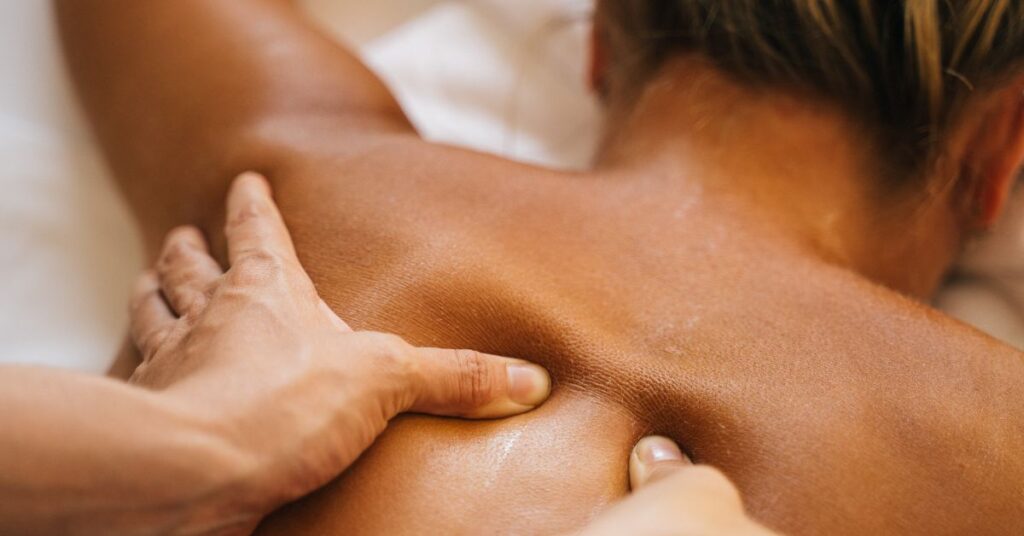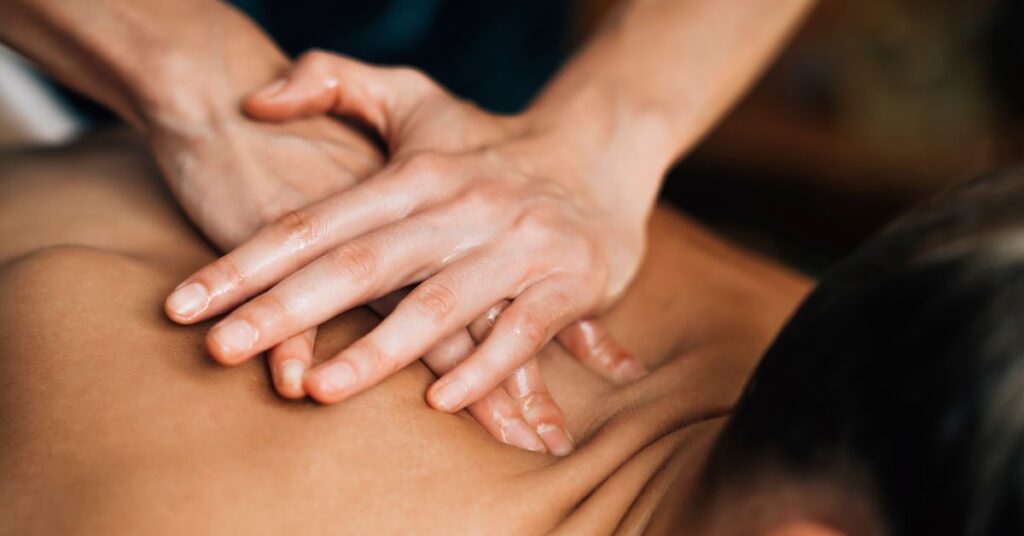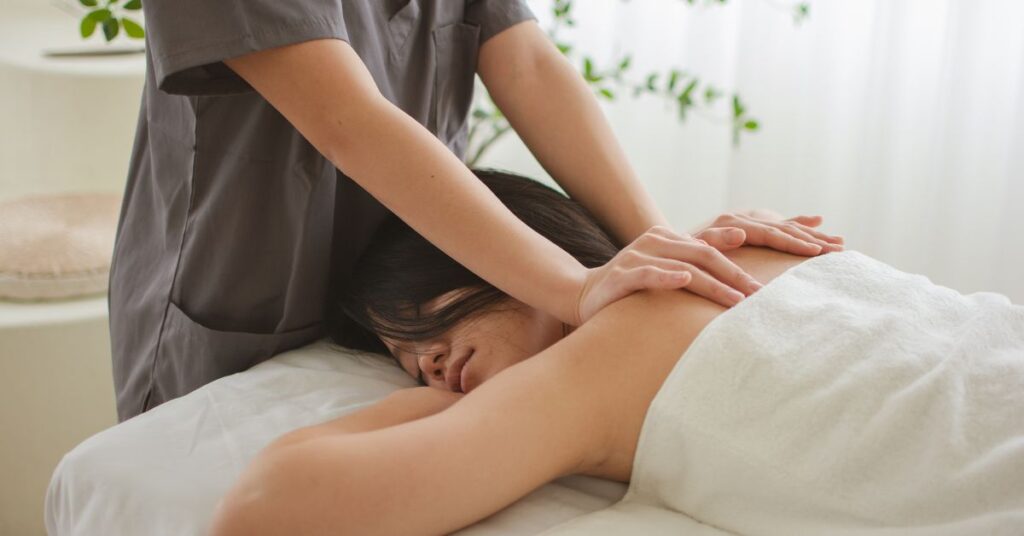Have you ever left a massage feeling more sore than relaxed? Or wondered when massage is painful why a seemingly soothing experience could sometimes be downright painful? If so, you’re not alone. Understanding why massages can occasionally be painful is crucial for making the most out of your massage therapy sessions and achieving the desired results.
In this article, we will explore when and why a massage might be painful and what you can do about it.
Table of Contents
Common Reasons for Pain During Massage

Muscle Tension and Knots
- When muscles are tight or knotted, applying pressure during a massage can cause discomfort.
- Knots, also known as trigger points, can develop in muscle tissue due to stress, overuse, or poor posture, leading to localized pain during massage.
Deep Tissue Techniques
- Deep tissue massage targets deeper layers of muscle and connective tissue to release chronic tension.
- The pressure used in deep tissue techniques may sometimes feel intense, causing temporary discomfort, especially if the muscles are particularly tense or sensitive.
Trigger Points and Referred Pain
- Trigger points are hyperirritable spots in muscle tissue that can cause pain in other areas of the body when pressure is applied.
- Referred pain, where the pain is felt in a different location from the trigger point, can occur during a massage when trigger points are stimulated.
Individual Sensitivity Levels
- Everyone’s pain tolerance and sensitivity levels vary.
- What feels comfortable for one person during a massage may feel painful to another, depending on factors such as muscle tension, stress levels, and overall health.
Underlying Health Conditions or Injuries
- Pre-existing health conditions or injuries, such as fibromyalgia, arthritis, or muscle strains, can increase sensitivity to pressure during massage.
- In some cases, applying pressure to affected areas may exacerbate pain or discomfort.
Further reading: What is a nuru massage?
Differentiating Between Good Pain and Bad Pain

Good Pain
- Good pain during a massage is often described as discomfort that leads to relief and improved mobility.
- It may feel like a deep stretching sensation, mild soreness, or a “hurts so good” feeling.
- Good pain typically occurs when muscles are being worked on to release tension, knots, or trigger points.
- It should feel manageable and gradually diminish as the massage progresses.
- Good pain is usually associated with therapeutic benefits, such as increased flexibility, reduced muscle tightness, and improved circulation.
Bad Pain
- Bad pain during a massage is any sensation that feels sharp, stabbing, or intolerable.
- It may be accompanied by feelings of burning, pinching, or radiating discomfort.
- Bad pain often indicates potential injury or excessive pressure being applied to sensitive areas.
- It does not improve with adjustments in pressure or technique and may worsen over time.
- Bad pain can be a sign that the massage therapist is using too much force or working beyond the client’s tolerance level.
- It is important to communicate any feelings of bad pain immediately to the massage therapist to prevent potential injury and ensure a safe and comfortable experience.
Further reading: How to massage scar tissue?
Factors Contributing to Painful Messages

Individual Sensitivity Levels
- Each person’s pain tolerance varies based on factors such as genetics, past experiences, and overall health.
- Some individuals may have a higher sensitivity to touch or pressure, making certain massage techniques feel more uncomfortable or painful.
Underlying Health Conditions
- Pre-existing health conditions, such as fibromyalgia, arthritis, or chronic pain disorders, can increase sensitivity to touch and pressure.
- Injuries, such as muscle strains or sprains, may also make certain areas of the body more tender or prone to discomfort during massage.
Muscle Tension and Tightness
- The presence of muscle tension, knots, or trigger points can contribute to discomfort during massage.
- Applying pressure to these areas may initially cause pain as the muscles release tension and toxins are flushed out.
Inappropriate Pressure or Technique
- Using excessive pressure or inappropriate techniques during massage can cause discomfort or pain.
- Deep tissue massage, for example, maybe too intense for some individuals if not applied properly or if the muscles are particularly sensitive.
Lack of Communication
- Failure to communicate preferences, concerns, or areas of discomfort with the massage therapist can result in an uncomfortable experience.
- It is essential for clients to openly discuss their pain tolerance, specific areas needing attention, and any medical conditions or injuries that may affect the massage.
Stress and Emotional Factors
- Stress, anxiety, or emotional tension can manifest physically in the body, leading to increased muscle tension and heightened sensitivity to touch.
- During a massage, these emotional factors may amplify sensations of discomfort or pain.
Inadequate Warm-up or Preparation
- Insufficient warming up of the muscles before applying pressure during massage can increase the likelihood of discomfort or pain.
- Proper warm-up techniques, such as light stretching or the application of heat packs, can help relax the muscles and prepare them for deeper work.
Further reading: How to give good massage?
Strategies for Managing Pain During Massage

Communication with the Massage Therapist
- Openly communicate your pain tolerance, preferences, and any areas of discomfort or sensitivity with your massage therapist before and during the session.
- Don’t hesitate to speak up if the pressure feels too intense or if you experience any sharp or unbearable pain.
Deep Breathing and Relaxation Techniques
- Practice deep breathing exercises during the massage to help relax tense muscles and alleviate discomfort.
- Focusing on your breath can also distract from sensations of pain and promote a sense of calm.
Request Adjustments in Pressure or Technique
- If certain areas of the body feel particularly sensitive or painful, ask the massage therapist to adjust the pressure or switch to a gentler technique.
- Remember that it’s okay to request modifications to ensure a comfortable and effective massage experience.
Use of Heat or Cold Therapy
- Apply heat packs or warm towels to tense or painful areas before the massage to help relax the muscles and increase blood flow.
- After the massage, consider using ice packs or cold therapy to reduce inflammation and soothe any residual soreness.
Take Breaks as Needed
- If you experience discomfort during the massage, don’t hesitate to ask for short breaks to give your muscles a chance to relax.
- Taking breaks can help prevent overstimulation and allow you to better tolerate the massage.
Focus on Relaxing Muscles
- Concentrate on consciously relaxing the muscles being worked on during the massage.
- Tensing up in response to pain can exacerbate discomfort, so try to consciously release tension and let the muscles soften.
Post-Massage Care and Recovery
Hydration
- Drink plenty of water after your massage to help flush out toxins released from your muscles during the session.
- Proper hydration can also help prevent dehydration and minimize muscle soreness.
Gentle Movement and Stretching
- Engage in gentle movement and stretching exercises to maintain flexibility and prevent muscle stiffness after the massage.
- Focus on stretching any areas that feel tight or tense to promote relaxation and improve circulation.
Avoid Overexertion
- Avoid strenuous activities or heavy lifting immediately after your massage to allow your muscles time to recover.
- Give yourself time to rest and relax to fully reap the benefits of the massage therapy session.
Apply Heat or Cold Therapy
- Consider using heat packs or warm towels on sore or tense areas to help soothe muscle discomfort and promote relaxation.
- Alternatively, ice packs or cold therapy can help reduce inflammation and alleviate any lingering soreness.
Listen to Your Body
- Pay attention to how your body feels after the massage and adjust your activities accordingly.
- If you experience any lingering discomfort or soreness, take it easy and give your muscles time to heal.
Schedule Regular Massages
- Incorporate regular massages into your wellness routine to maintain muscle health, reduce tension, and prevent future pain or injury.
- Discuss with your massage therapist the frequency and duration of massages that best suit your needs and lifestyle.
Follow Up with Self-Care Practices
- Practice self-care techniques such as meditation, deep breathing exercises, or gentle yoga to further promote relaxation and stress relief.
- Prioritize rest to allow your body to fully recover and rejuvenate after the massage.
By following these post-massage care and recovery tips, you can maximize the benefits of your massage therapy session and support your body’s healing process. Remember to listen to your body and give yourself the time and attention needed to maintain optimal muscle health and overall well-being.
Conclusion
Navigating the sometimes-painful terrain of massage therapy can be a transformative journey toward improved physical and mental well-being. By understanding the factors contributing to discomfort during massages and employing effective strategies for managing pain, you can optimize the therapeutic benefits of each session.
Never forget how important it is to communicate with your massage therapist. A customized and comfortable experience is possible when your pain tolerance, preferences, and areas of concern are openly discussed. Knowing the difference between “good pain” and “bad pain” gives you the power to speak up for yourself and make sure your therapy is both safe and efficient.
Recuperation and post-massage care are essential to preserving the session’s advantages. You may fully benefit from your massage therapy session by maintaining muscular health and relaxation with self-care routines, mild movement, and proper hydration.
Whether you’re seeking relief from chronic pain, reducing stress, or simply indulging in self-care, embracing the journey of massage therapy with informed awareness and proactive communication can lead to profound healing and rejuvenation. Here’s to your continued wellness and vitality through the transformative power of massage.
